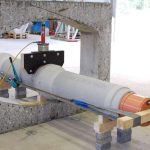
Concrete has completely different properties when it is the plastic stage and when hardened. Concrete in the plastic stage is also known as green concrete. The properties of green concrete include:
1. Workability
2. Segregation
3. Bleeding
4. Harshness.
The properties of hardened concrete are:
1. Strength
2. Resistance to wear
3. Dimensional changes
4. Durability
5. Impermeability.
Properties of Green Concrete
1. Workability:
This is defined as the ease with which concrete can be compacted fully without
segregating and bleeding. It can also be defined as the amount of internal work required to fully compact the concrete to optimum density. The workability depends upon the quantity of water, grading, shape and the percentage of the aggregates present in the concrete. Workability is measured by
(a) The slump observed when the frustum of the standard cone filled with concrete is lifted and removed.
(b) The compaction factor determined after allowing the concrete to fall through the compaction testing machine.
(c) The time taken in seconds for the shape of the concrete to change from cone to cylinder when tested in Vee-Bee consistometer.The suggested values of workability
2. Segregation:
Separation of coarse particles from the green concrete is called segregation.
This may happen due to lack of sufficient quantity of finer particles in concrete or due to throwing of the concrete from greater heights at the time of placing the concrete. Because of the segregation, the cohesiveness of the concrete is lost and honeycombing results. Ultimately it results in the loss of strength of hardened concrete. Hence utmost care is to be taken to avoid segregation.
3. Bleeding:
This refers to the appearance of the water along with cement particles on the
surface of the freshly laid concrete. This happens when there is excessive quantity of water in the mix or due to excessive compaction. Bleeding causes the formation of pores and renders the concrete weak.Bleeding can be avoided by suitably controlling the quantity of water in the concrete and by using finer grading of aggregates.
4. Harshness:
Harshness is the resistance offered by concrete to its surface finish. Harshness is due to presence of lesser quantity of fine aggregates, lesser cement mortar and due to use of poorly graded aggregates. It may result due to insufficient quantity of water also. With harsh concrete it is difficult to get a smooth surface finish and concrete becomes porous.
Properties of Hardened Concrete
1. Strength:
The characteristic strength of concrete is defined as the compressive strength of
150 mm size cubes after 28 days of curing below which not more than 5 per cent of the test results are expected to fail. The unit of stress used is N/mm2. IS 456 grades the concrete based on its characteristic
Till year 2000, M15 concrete was permitted to be used for reinforced concrete works. But IS 456–2000 specifies minimum grade of M20 to be used for reinforced concrete works.Strength of concrete depends upon the amount of cement content, quality and grading of aggregates, water cement ratio, compaction and curing.
Strength of concrete is gained in the initial stages. In 7 days the strength gained is as much as 60 to 65 per cent of 28 days strength. It is customary to assume the 28 days strength as the full strength of concrete. However concrete gains strength after 28 days also.
2. Dimensional Change:
Concrete shrinks with age. The total shrinkage depends upon the constituents of concrete, size of the member and the environmental conditions. Total shrinkage is approximately 0.0003 of original dimension.
The permanent dimensional change due to loading over a long period is termed as creep. Its value depends upon the stress in concrete, the age of the concrete at the time of loading and the duration of the loading.
The ultimate creep strain may be estimated from the values of creep coefficient. The creep coefficient is defined as ultimate creep strain divided by the elastic strain at the age of loading.
The size of concrete may change due to thermal expansion also. The coefficient of thermal expansion depends upon the nature of cement, the type of aggregates, cement content, relative humidity and the size of the sections of the structural elements. Table 3.6 shows the coefficient of thermal expansion of concrete with different types of aggregates.
3. Durability:
Environmental forces such as weathering, chemical attack, heat, freezing and
thawing try to destroy concrete. The period of existance of concrete without getting adversely affected by these forces is known as durability. Generally dense and strong concretes have better durability. The cube crushing strength alone is not a reliable guide to the durability. Concrete should have an adequate cement content and should have low water cement ratio.
4. Impermeability:
This is the resistance of concrete to the flow of water through its pores.Excess water during concreting leaves a large number of continuous pores leading to the permeability.Since the permeability reduces the durability of concrete, it should be kept very low by using low water cement ratio, dense and well graded aggregates, good compaction and continuous curing at low temperature conditions. The cement content used should be sufficient to provide adequate workability with low water cement ratio and the available compaction method.


